Books
The Captive Queen/Captive Queen (2010)
"A vibrant historical novel." (Marie Claire)
"A stunning portrayal ... many writers attempt the kind of heart-stopping historical fiction Weir has mastered. Few come close to her winning combination of brisk pacing, solid scene-setting and the vivid descriptions a novel set in such a far-away time absolutely demands."
(Denver Post)
"Stunning... As always, Weir renders the bona fide plot twists of her heroine's life with all the mastery of a thriller author, marrying historical fact with licentious fiction." (The Star Tribune)
"Wife of two kings and mother of two more, Eleanor of Aquitaine may have lived in the misty past of the 12th century, but noted historical biographer and novelist Alison Weir brings her to life in this engaging and dramatic story... Weir laudably sticks to the historic facts while simultaneously using her imaginative gifts." (Newark Star-Ledger)
"Should be savoured... Weir wastes no time captivating her audience." (Seattle Post-Intelligencer)
"As in her previous novels, Weir frequently straddles a fine line between bodice ripper and historical fiction, and here, too, Eleanor's imagined erotic escapades prove a pleasant backdrop to her political plotting. Weir knows how to wrest the most pleasure from the lives of long-dead royalty. As always, she renders the bona fide plot twists of her heroine's life with all the mastery of a thriller author, marrying historical fact with licentious fiction to create an escapist book perfect for summer reading." (Minneapolis Star-Tribune)
"Exceedingly well written and researched, this will more than satisfy and enchant historical novel fanatics. Weir's attention to detail, engaging dialog and engrossing depiction of Eleanor's life make the novel an invaluable addition to the genre. Augmenting Weir's extensive historical repertoire (nonfiction and fiction), a copy or two of this wonderful novel on the shelves will never gather dust." (Library Journal)
"Weir brings all her talents to bear on this comprehensive novel, including a biographer’s intimate knowledge of the period that lends a particular authenticity to Captive Queen." (Curled up with a Good Book)
"The history itself is inherently dramatic, augmented here by Weir’s usual lush detail, which stimulates rather than detracts from the well-paced narrative." (Booklist)
"Alison Weir is known for her informative and entertaing historical novels that bring England's history to life, and Captive Queen is just the latest in a long line of fabulous reads by her. With her novels, Alison Weir breathes fresh life into historical characters and stories, bringing a new perspective to a woman who refused to let men rule her life, her heart, and country without a fight. Alison Weir has joined Jean Plaidy and Philippa Gregory as some of the best writers of English historical novels." (Night Owl Reviews)
"Though the bare bones of history have ensured that Eleanor's life with Henry II will always be considered one of the most dramatic real-life love stories known to us, Alison Weir's novel adaptation fleshes it out and makes it far more vivid. Captive Queen will captivate both readers curious about medieval history and those who are looking for the excitement and distraction of a satisfying novel." (suite 101)
"For fans of medieval Europe, this book is a must read. Just beware that the author made it as authentic as possible, right down to the sexism of the time period." (Feminist Review)
"One of the most tumultuous, complex, deep, and fascinating relationships in history is portrayed brilliantly in Captive Queen by Alison Weir. This is one of the most dramatic and fascinating portrayals of a powerful and passionate marriage turned to hate and estrangement. The marriage between King Henry II of England and Eleanor of Aquitaine is deliciously portrayed... The novel is a brilliant portrayal of one of the most complicated marriages and relationships in history. This is Alison Weir's finest historical fiction novel and one of the best portrayals of this time period, these historical figures, and the events that took place." (Pittsburgh Examiner)
"Alison Weir caught [Henry and Eleanor's] true relationship perfectly in her writing, as I imagined it would have been. She brought to life the places they lived and ruled... Kudos to you, Alison Weir, for bringing this story to life and taking me on Eleanor's adventure that was her life."
(Leah Weller, Goodreads)

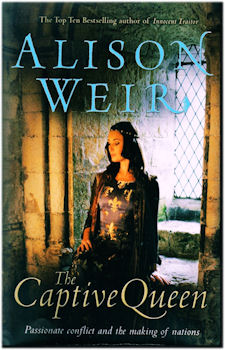

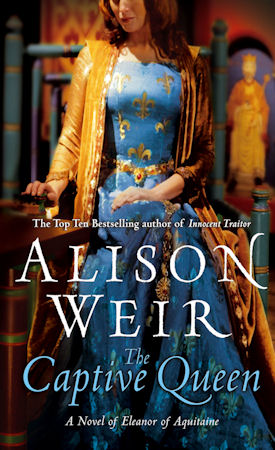

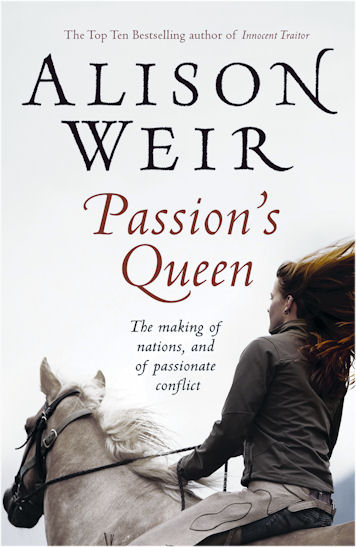
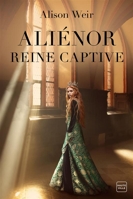
Above: Preliminary jacket designs and concepts. The U.K. jacket was shot in the Great Tower at Dover Castle, using the same model as on the paperback jacket for The Lady Elizabeth. Bottom right: original French jacket concept. My original title for the book was A Marriage Of Lions.
To see videos of me speaking about The Captive Queen, go to:
http://www.youtube.com/watch?v=dwYgekFzsGU
http://www.youtube.com/watch?v=TL8NOZ_y7nY&feature=related
"In The Captive Queen, Alison Weir conjures up the world of the passionate and notorious twelfth-century queen, Eleanor of Aquitaine, the beautiful woman who abandoned her first husband, Louis VII of France, for a younger man, the future Henry II of England. Thus began one of the most tumultuous royal marriages in history, a marriage based on lust and a mutual struggle for power. This is a vivid portrait of a legendary, fascinating woman.”
It took me eight years to persuade my publishers to let me write a biography of Eleanor of Aquitaine. I was told that a life of a woman who had been dead for eight hundred years would not have the same appeal as a book on Elizabeth I or the six wives of Henry VIII because the sources just don`t exist. And that is true, but despite the gaps in our knowledge of her, Eleanor of Aquitaine is still one of the towering figures of the Middle Ages - and, indeed, one of the most enduringly popular female figures in history.
I did get to publish my biography in the end, in 1999, and to my astonishment, quickly discovered that an overwhelming number of readers were passionate about Eleanor. Every event was a sell-out, with people even standing or sitting on the floor. So many had been inspired by Katharine Hepburn`s dynamic portrayal of Eleanor in the 1968 film, The Lion in Winter, and some told me they made annual `pilgrimages` to the great Queen`s tomb at Fontevrault. Others sent me photographs of corbel heads in tiny French churches, or wrote of colourful local legends. In the end, Eleanor of Aquitaine: By the Wrath of God, Queen of England, turned out to be my best-selling history book to date.
I had originally researched Eleanor in the 1970s, along with all the other medieval queens of England, for a composite biography that has yet to be published, although a lot of the research has been used for other books. Thus, when I came to write Eleanor`s life, I had a rich bank of source material ready to hand, and only needed to update it. I soon found, though, that what my editor had said was very true, and that medieval biography, particularly of women, is essentially the piecing together of fragments of information into what will hopefully be a cohesive narrative; and that there will always be gaps that we cannot hope to fill.
A historian has to work within the strict constraints imposed by the source material and credible speculation. A novelist, however, is able to use her imagination to fill in the gaps, although - again - what she writes must be credible within the context of what is known about her subject.
It was while I was researching Eleanor of Aquitaine in 1998 that it occurred to me that I wanted to write a novel about her, one in which I could develop ideas and themes that had no place in a history book, but which - based on sound research and educated guesses - could help to illuminate her life and explain her motives and actions. A historian uses such inventiveness at her peril - but a novelist has the power to get inside her subject`s head and actually be her; and that can afford one insights that would not be permissable to a historian, and yet can have a legitimate value of their own.
I could not, of course, publish a novel about Eleanor in 1998, so I chose to write one about Lady Jane Grey instead. But when a decade had passed since the publication of my biography, I was finally able to fulfill my dream of writing a novel about Eleanor. Yes, it is fiction; yes, I have filled gaps - with integrity, I trust. Writing this novel presented me with one of the greatest challenges of my career: I had to do justice to the character and reputation of this fabled and celebrated woman, and it is my hope that those who read it will find that the book captures the spirit of the real Eleanor of Aquitaine.
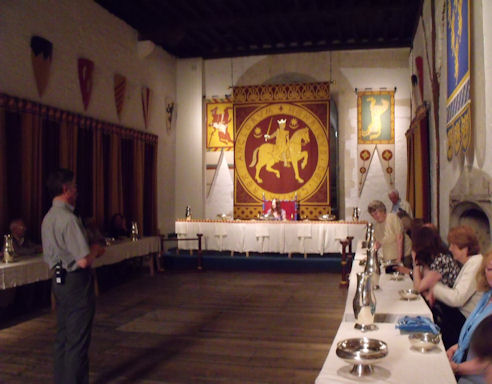

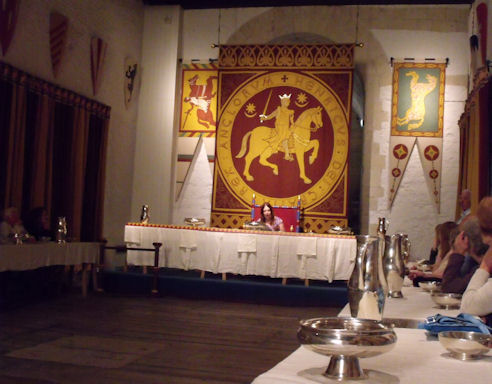
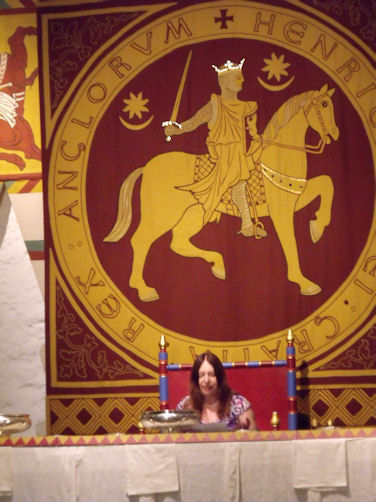
Above: Speaking about The Captive Queen in the Great Tower at Dover Castle.
INTERVIEW WITH NEAL CONAN FOR TALK OF THE NATION ON NATIONAL PUBLIC RADIO, U.S.A., 2010
NC: And now, murder, war, lies, deceit. England's Tudor Dynasty featured some of the most significant and salacious monarchs in history. British historian Alison Weir has conducted exhaustive academic research into the lives, personalities and lusts of, among others, Henry VIII, Elizabeth I and Eleanor of Aquitaine. But Weir then used that history as the basis of a series of novels. Historical fiction is one way to describe what she does - bodice-ripper may be more specific. Alison Weir's latest novel is Captive Queen: A Novel of Eleanor of Aquitaine, and she joins us here in Studio 3A. It's a pleasure to have you on the program today.
AW: It's a pleasure to be here. Thank you.
NC: Is bodice-ripper an accurate description?
AW: Perhaps for parts of the book, yes.
NC: Well, the good parts.
AW: Yes, yes... (laughter). The juicy parts, yes. But, actually, I was telling it as it is because we want to understand why, when this marriage goes wrong, what Eleanor has lost.
NC: And it is a great deal.
AW: Yes, it is, absolutely. Because this is a marriage of princes, this is a dynastic partnership. It's the founding of an empire. But it's also a marriage founded on lust and then on love.
NC: And those are not always synonymous, nor do they exist in parallel for the same amount of time.
AW: No, absolutely not. And it was one of the most tempestuous of royal marriages ever.
NC: And, well, you've got a rich tapestry to choose from.
AW: Yes, I have indeed. And it's always hard to choose subjects, but this is one I've wanted to do for a long, long time.
NC: How did you make the decision to go from historian to being a historical novelist?
AW: When I was researching my biography of Eleanor of Aquitaine in the late 90s, I realized there were many gaps that I couldn't fill, and that's tantalizing. And the only way I could do that would be to write a novel. But, of course, I couldn't write a novel about Eleanor at that time because it would have been in competition with my biography. So I wrote about Lady Jane Grey instead.
NC: And do you enjoy the novels more than your histories?
AW: Honestly, I enjoy them equally now. With novels, I had to go back to square one and learn my craft all over again, and go through that learning curve of how to write fiction as opposed to history.
NC: What's the most difficult part to learn?
AW: It's showing rather than telling. It's not just instructing your readers. It's making them live it.
NC: So how closely do you feel you need to adhere to the facts as you tell your fictional stories?
AW: I feel very strongly that where the facts exist, a historical novelist should use them if they're writing about a person who really lived, because a lot of people come to history through historical novels. I did. And a lot of people want their history that way. And I know, because readers tell me so regularly and forcefully, that they care that what they're reading is close to the truth.
NC: I'm a great fan of Bernard Cornwell these days, and Patrick O'Brian's books were - well, I couldn't wait for those to come out. It was great stuff, and learned a great deal about the Napoleonic Wars in the process.
AW: Well, you do. It's a fun way of learning history.
NC: And when you were a kid, you said you came to history through this. What was the lure for you?
AW: My mother marched me into a library when I was fourteen and said get a book, because I had graduated from books to comics. And I got this really lurid historical novel about Katherine of Aragon, Henry's Golden Queen, and I devoured it in two days. And it sent me rushing off to the serious history books in my school library to find out what really happened.
NC: And you then became a specialist in the Tudor courts.
AW: I did. But it took a long while. History was a hobby for about twenty years before I got into print.
NC: But why the Tudors especially?
AW: I think that they're larger-than-life, dynamic, forceful characters. And this is a dramatic period in history. You couldn't make it up: a king with six wives? Two of them lose their heads? A seventeen-year-old girl, queen for nine days, executed? It - you know, it's quite dramatic stuff.
NC: Oh, it's great stuff. When you write about Lady Jane Grey, she's there in the tower awaiting her execution, and you talk about her anxiety. Any evidence to support the anxiety, or is that where the fiction comes in?
AW: That's where the fiction comes in. You imagine how she must have felt. And she was very strong. We have her letters, so we know that she did gain strength, and actually she argued against a reprieve.
NC: Argued against a reprieve?
AW: Against - she was offered her life if she would convert to the Catholic faith, and she argued against that, knowing she would die.
NC: A woman of principle.
AW: Yes, a feisty dogmatic teenager who took it too far.
NC: Alison Weir is our guest. Let's go to Courtney, with us from Mayfield in Kentucky.
COURTNEY: Hi. How are you all today?
NC: Very good.
AW: Hi, Courtney.
COURTNEY: Good. Ms. Weir, I just want to call in and let you know I didn't start getting interested in historical fiction until I started reading some of Philippa Gregory. But once I really got into it, I have devoured everything you have written, and I really think you reach a broader spectrum than you would ever realize because I just finished Eleanor of Aquitaine and I cannot wait to read Captive Queen. But it has just sparked an interest in medieval England and medieval Europe overall that just fascinates me. I think what you're doing is a wonderful thing.
AW: Thank you so much. I'm deeply touched. It's wonderful to hear something like that, to get that feedback.
NC: Courtney, what's your favourite part?
COURTNEY: Eleanor of Aquitaine. She is so fascinating, and there's so little known about her. And while I was reading your book on her, I was amazed that you had pieced so much together about her life. I mean, it's just - it's fascinating, the work you do. And I'm an amateur history buff, but your books have had a great impact on me. And I'm very grateful for it. You definitely made me broaden my knowledge.
AW: Well, you've made my day. Thank you very much, Courtney.
COURTNEY: Thank you all. You all have a great day.
AW: Thank you.
NC: Thanks very much for the call. Here's an email from Sarah in Ankeny, Iowa: “I have read many of Alison Weir's nonfiction books. I was thrilled when she began to write historical fiction. Her novel on Lady Jane Grey was excellent. Any chance you'll do a novel on the Princes in the Tower?”
AW: That's the next one.
NC: Good Lord. (laughter) That's your agent writing in from Ankeny in Iowa. Again, you're competing, though, with some pretty fancy writers. I mean, you got Shakespeare, in addition, all the other historians here.
AW: I'm not setting myself up against Shakespeare! No. I just do what I do and hope people enjoy it.
NC: Let's go next to Dave, with us from Nashua in Iowa.
DAVE: Hey, hello. I'm - I kind of got into historical fiction on accident. I came upon a James Michener book, about two years ago. And since then, I've read about twelve or thirteen of them. And his are - if you're not familiar with them, they're a little different. Instead of looking at one time period, they look at one particular geographical area and kind of follow that.
AW: Hawaii, wasn't that by James Michener?
DAVE: That is actually the only one I haven't read yet of his historical novels. But - that's - it's on my list. He's written at least ten or twelve that kind of follow that same formula.
NC: He drove me crazy, though, with one that was Space that he wrote about and in which he restages the Battle of Leyte Gulf, and for extra-dramatic effect refloats a Japanese battleship that had been sunk the day before. (laughter)
AW: Naughty.
NC: Very bad. Mr. Michener is beyond my criticism now, however. (laughter) Dave, thanks very much for the call. Here's an email from Amanda in Anchorage: “Do you think that truthfulness within history books and accuracy has fallen to the wayside as time has gone on?”
AW: I would say yes. But, I mean, if you could go back, you could look at historical novels of the '50s to the '70s and you will find inaccuracies in them. I would say that it's more common with filmed versions of history in which truthfulness and accuracy has fallen by the wayside.
NC: Well, in which they're trying to compress time.
AW: They think it's demeaning to follow the facts.
NC: Yeah. Well, it takes up a lot of time for that. I was interested what you said, though, about having to interpolate peoples' emotions. The historians are bitterly criticized, the kind of historians who say, as he stared across the English Channel, Napoleon must have felt - because you can't say that.
AW: You can only say it if you've got an original source that you can use to support it.
NC: Let's go next to Karen, with us from Cincinnati.
KAREN): Hi. Yes. I wanted to say that my husband and I - my husband is British - devoured The Tudors, but we always kept Alison's book so we could fact check everything that was going on.
AW: I like it! (laughter)
KAREN: And my husband has read it cover to cover a couple times.
AW: Thank you.
NC: Did you discover any discrepancies, Karen?
KAREN: Yes. Supposedly, his best friend, so to speak, the one that dies in the end, doesn't really exist, or not in that way. And there were other things that didn't quite work out, so...
NC:I think it was a revelation to most people that Henry wasn't fat his whole life.
KAREN: No. No. That did come up, too.
AW: There were quite a few revelations such as Cardinal Wolsey cutting his throat. I've never heard of that!
KAREN: Yeah. Thank you so much.
NC: Okay. And you've studied this for years.
AW: I have, absolutely. And this sister called Margaret, who married the King of Portugal, who on earth was she meant to be?
KAREN: Yes.
CONAN: Well, perhaps...
AW: ...or a radiator in a bedroom.
NC: Well, it was - that must have made things considerably more comfortable.
( laughter)
KAREN: Well, thanks for taking my call.
NC: Karen, thanks very much. Appreciate it. Let's go next to Jennifer, with us from San Francisco.
JENNIFER: Hi. First, I just want to say thank you so much for having this author on the air and this wonderful topic. The thing I wanted to say is I'm a huge proponent of passion-based, child-based learning and reform in the education system. And I truly feel that it would be wonderful to have so much more historical writing in the educational system. I think, especially for females, it's a wonderful way for them to connect with the people behind the dry facts that are often taught in our school system. So I just wanted to put that out there. And I also wanted to ask the author, as I have not had the benefit of reading her books yet, which book she would recommend I start with.
AW: If you would like to read non-fiction, I suggest The Lady in the Tower: The Fall of Anne Boleyn. It's probably the most exciting story.
NC: Don't tell me how it comes out.
AW: I'm not going to. (laughter) I also suggest any of the three novels.
NC: Though she suggests the use of these historical fiction in schools, they would have to be in the English class and not in the history class.
AW: I think the fiction would, but I do think that history is full of great stories. And when I write history books, I write them as a narrative.
NC: Alison Weir is our guest. We're talking about her latest novel, Captive Queen: A Novel of Eleanor of Aquitaine. You're listening to TALK OF THE NATION from NPR News. And let's go next to Frank, with us from Menlo Park in California.
FRANK: Yes, hi. Thanks for taking my call. I've really enjoyed reading Alison Weir's biography of Queen Elizabeth. And she said that she likes to write about the Tudor period because of the larger-than-life characters, and I agree with that. I wonder if she's considered writing any book about Queen Elizabeth's wars in Ireland and all of the larger-than-life characters there - Hugh O'Neill, Essex, Lord Mountjoy, Shane O'Neill and so forth, as well as the time, money and headaches that the Irish wars caused for Elizabeth.
NC: Yeah. In all the movies and a lot of the books, everybody's just arriving back from Ireland...
AW: They are indeed. I have actually written about that in my biography, Elizabeth the Queen. The problem is, I'm always being steered by my publishers in the direction of writing about strong female characters. So I don't think that would get off the ground with them, unfortunately, although it's a fascinating subject.
NC: Thanks very much. Let's go next to Jean, with us from Holland, Michigan.
JEAN: Hi. I am just avid to get at this book. I have not heard of this author, but I'll probably call my local bookseller and order your book.
AW: Thank you so much.
JEAN: I've heard so much about the Plantagenets that I want to read more.
NC: Appreciate the phone call. This is Jennifer, with us from Charlotte.
JENNIFER (Caller): Hi, how are you? Thanks so much for taking my call.
NC: Sure.
JENNIFER: I just wanted to echo a previous caller who talked about education. I wish there were more books targeted for young children because for millions of children historical fiction is not only a way to just learn the facts, but it's to, as your author was speaking, to imagine what it would be like to be in that place...
NC: And go into that portal in time and begin to understand our past. Jennifer, thanks very much for the call. We appreciate it. Have you ever considered writing for young people?
AW: Yes, I have. And I've written up a book that was in the Quick Reads series in Britain, and it's for emergent adult readers, in the kind of language that would be accessible to people with a reading age of nine to twelve.
NC: So the next one is about the boys in the Tower.
AW: Yes, but that will be an adult novel. That is just one theme in it. The next biography is about Mary Boleyn. That's the next book to come out.
NC: That's Anne's sister?
AW: Yes, that's correct. Yes.
NC: All right. Thank you very much for being with us, and good luck with the book. We appreciate it.
AW: Thank you very much.
THE ROYAL PRISONER OF SARUM
Heritage Today, October 2010

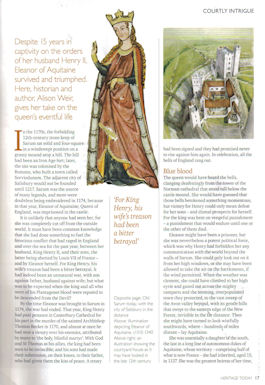
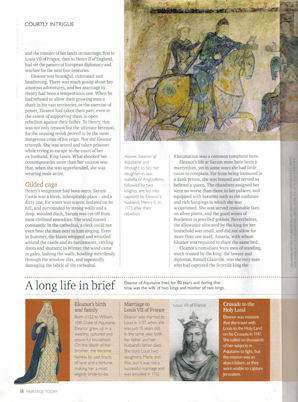
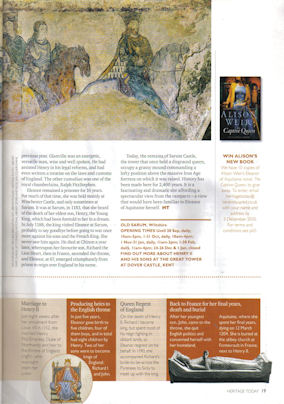
In the 1170s, the forbidding twelfth-century stone keep of Sarum sat solid and four-square in a windswept position on a grassy mound atop a hill. The hill had been an Iron-Age fort; later, the site was colonised by the Romans, who built a town called Sorviodunum. The adjacent city of Salisbury would not be founded until 1217. Sarum was the source of many legends, and more were doubtless being embroidered in 1174, because in that year, Eleanor of Aquitaine, Queen of England, was imprisoned in the castle.
It is unlikely that anyone had seen her, for she was completely cut off from the outside world. It must have been common knowledge that she had done something to fuel the ferocious conflict that had raged in England and over the sea for the past year, between her husband, King Henry II, and their sons, the latter being abetted by Louis VII of France – and by Eleanor herself. For King Henry, his wife`s treason had been a bitter betrayal. It had indeed been an unnatural war, with son against father, husband against wife; but what was to be expected when the King and all who were of his Plantagenet blood were reputed to be descended from the Devil?
By the time Eleanor was brought to Sarum in 1174, the war had ended. That year, King Henry had done penance in Canterbury Cathedral for his part in the murder of the sainted Archbishop Thomas Becket in 1170, and almost at once he had won a victory over his enemies, attributed by many to `the holy, blissful martyr`. With God and St Thomas as his allies, the King had been seen to be invincible; and his sons had made their submission, on their knees, to their father, who had given them the kiss of peace. A treaty had been signed, and they had promised never to rise against him again. In celebration, all the bells of England rang out.
The Queen would have heard the bells, clanging deafeningly from the tower of the half-built Norman cathedral that stood dark and squat on the hill beneath the castle mound. She would have guessed that those bells betokened something momentous, but victory for Henry could only mean defeat for her sons - and dismal prospects for herself. For the King was bent on vengeful punishment – a punishment that would endure until one or the other of them died.
Eleanor might have been a prisoner, but she was nevertheless a potent political force, which was why Henry had forbidden her any communication with the world beyond the walls of Sarum. She could only look out on it from her high windows, or she may have been allowed to take the air on the battlements, if the wind permitted. When the weather was clement, she could have climbed to her high eyrie and gazed out across the mighty ramparts and the teeming, overpopulated town they protected to the vast sweep of the Avon valley beyond, with its gentle hills that swept to the eastern edge of the New Forest, invisible in the far distance. Then she might have turned to look wistfully southwards, where – hundreds of miles distant – lay Aquitaine.
She was essentially a daughter of the south, the last in a long line of autonomous dukes of Aquitaine, whose territory – comprising half of what is now France - she had inherited, aged fifteen, in 1137. She was the greatest heiress of her time, and the transfer of her lands on marriage, first to Louis VII of France, then to Henry II of England, had set the pattern of European diplomacy and warfare for the next four centuries.
Eleanor was beautiful, cultivated and headstrong. There was much gossip about her amorous adventures, and her marriage to Henry had been a tempestuous one. When he had refused to allow their growing sons a share in his vast territories, or the exercise of power, Eleanor had taken their part, even to the extent of supporting them in open rebellion against their father. To Henry, this was not only treason but the ultimate betrayal, for the ensuing revolt proved to be the most dangerous crisis of his reign. Nor did Eleanor triumph. She was seized and taken prisoner whilst trying to escape to the court of her ex-husband, King Louis. What shocked her contemporaries more than her treason was that, when she was apprehended, she was wearing male attire.
Henry`s vengeance had been stern. Sarum Castle was a bleak, inhospitable place – and a dirty one, for water was scarce. Isolated on its hill, and surrounded by strong walls and a deep, wooded ditch, Sarum was cut off from most civilised amenities. The wind roared constantly. In the cathedral, a clerk could not even hear the man next to him singing. Even in summer, the blasts whipped and whistled around the castle and its battlements, rattling doors and shutters; in winter, the wind came in gales, lashing the walls, howling mercilessly through the window slits, and repeatedly damaging the fabric of the cathedral. Rheumatism was a common complaint here.
Eleanor`s life at Sarum must have been a martyrdom, yet in some ways she had little cause to complain. Far from being immured in a dank prison, she was housed and served as befitted a queen. The chambers assigned her were no worse than those in her palaces, and equipped with luxuries such as the cushions and rich hangings to which she was accustomed. She was served reasonable fare, on silver plates, and the good wines of Bordeaux in jewelled goblets. Nevertheless, the allowance allocated by the King for her household was small, and did not allow for more than one maid, Amaria, with whom Eleanor was required to share the same bed.
Eleanor`s custodians were men of standing, much trusted by the King: the lawyer and diplomat, Ranulf Glanville, was the very man who had captured the Scottish King the previous year. Glanville was an energetic, versatile man, wise and well-spoken. He had assisted Henry in his legal reforms, and had even written a treatise on the laws and customs of England. The other custodian was one of the royal chamberlains, Ralph FitzStephen.
Eleanor remained a prisoner for sixteen years. For much of that time, she was held mainly at Winchester Castle, and only sometimes at Sarum. It was at Sarum, in 1183, that she heard of the death of her eldest son, Henry, the Young King, which had been foretold to her in a dream. In July 1188, the King visited Eleanor at Sarum, probably to say goodbye before going to war once more against his sons and the French King. She never saw him again. He died at Chinon a year later, whereupon her favourite son, Richard the Lion Heart, then in France, ascended the throne, and Eleanor, at 67, emerged triumphantly from prison to rule England in his name.
Today, the remains of Sarum Castle, the tower that once held a disgraced queen, occupy a grassy mound commanding a lofty position above the massive Iron-Age fortress on which it was raised. History has been made here for five thousand years. It is a fascinating and dramatic site affording a spectacular view from the ramparts – a view that would have been familiar to Eleanor of Aquitaine herself.
A VISIT TO FONTEVRAUD L`ABBAYE
By ALISON WEIR
(Appendix to the Waterstone's edition of the hardback publication of The Captive Queen, 2010)
On the drive north from the Dordogne, we broke our journey at Fontevraud to see the great abbey where the early Plantagenets had been buried. The little town – a pretty hotchpotch of white buildings and grey roofs - was lazing in the late-afternoon heat, its pavements dappled by the shades of tress and fluttering leaves, with here and there an inviting bar or brasserie, or an ancient church.
For years, I had wanted to come here. It felt as if I was making a pilgrimage to a shrine, a shrine to history. From the age of fourteen, I had thrilled to tales of the turbulent Devil`s brood, as King Henry II and his warring family were often called, and had read everything that had been written about them. And those early studies had in time borne fruit, for soon my biography of Henry`s great queen, Eleanor of Aquitaine, was to be published. It seemed most fitting, therefore, that I should be here, on this beautiful August day, in the place where my heroine had been laid to her rest nearly eight centuries before.
Lucy, my teenage daughter, accompanied me to the massive abbey complex. We wandered through peaceful cloisters, inspected the ruins of the nuns` kitchen, which had been built by the bounty of Queen Eleanor herself, and finally made our way through what remained of the old prison, which was what Eleanor`s Fontevrault had become after the French Revolution.
Before visiting the church, which I had purposefully saved until last, I could not resist the urge to check out what was on sale in the bookshop, and was not disappointed, for there were several books on the abbey crying out to be bought, new French works on Eleanor and the other Plantagenets, and a fascinating historical journal featuring an article on the burials at Fontevraud, which – after buying it – I perused hastily.
`Damn!` I muttered.
`What is it, Mum?` Lucy asked. She had been standing by patiently, waiting for me to finish my feverish browsing.
`It seems they are still here, the bones of the Plantagenets,` I fretted. `In my book, I`ve written that they were exhumed and scattered at the time of the French Revolution. But now they`ve disproved that, and it`s too late to change it. It`s almost certain that the Plantagenet vault was cut through in the eighteenth century to allow for the burial of two French princesses, and that the old bones were reburied elsewhere. Where, we do not know, but they are here somewhere.`
`I thought they`d be in the tombs you told me about,` Lucy said.
`No. The tombs and effigies were originally placed above the vault, and have been moved several times. They were even going to ship them to Westminster Abbey in the nineteenth century. Come on, I want to see them! I`ve waited years for this.`
When we entered the soaring abbey church, we were both struck by the quality of light that illuminated its white walls and elegant colonnades of pillars, giving the building a sense of space and serenity, of timeless worship reaching up to Heaven.
`It`s beautiful,` Lucy breathed. `I want to be married here!`
`Yes, it would make a lovely setting for a wedding,` I replied, imagining beautiful Lucy in a cloud of white standing with some unknown young man before the altar, the sun`s rays bathing them like a benediction. I now knew what had drawn Queen Eleanor, eight centuries before, to this wonderful, holy place.
The four surviving Plantagenet tombs lay ahead of us, two by two, in the middle of the nave. I approached them almost with reverence, glad to see that there were no crowds of tourists swarming about them. In fact, there were very few people in the abbey that late in the afternoon, just a few souls wandering contentedly in the aisles.
And there they were at last: Eleanor and Henry, side by side, united in death as they had not been in life; and Eleanor`s beloved son, King Richard the Lion Heart, alongside her daughter-in-law, Isabella, the wife of King John.
`The colours! They`re amazing,` I exclaimed in hushed tones, gazing lovingly upon the distressed but vivid hues of the painted effigies, or gisants. `I never realised that the colours would be so bright after all these centuries. No one has never captured that in photographs.`
Others were stopping to stare or pay homage. I stood steadfastly beside Eleanor of Aquitaine`s effigy, wishing to capture the moment forever, waiting until the tourists moved on. At length, Lucy contrived to drag me away so that we could look at the rest of the church – but not for long. Again and again I was drawn back to the tombs, so that I could drink in the details and imprint the image on my brain for always.
By the time I returned to gaze on the effigies for the third time, Lucy had got bored with all the tomb worship, and wandered off in the direction of the shop. She had been threatening to buy me a tiny plaster model of Eleanor`s tomb, `so that you can have it beside you when you write`. I had had to grin at that.
An elderly woman was standing beside the gisants, smiling down wistfully at King Richard. My eye was drawn to her, for she cut an impressive figure, with her tall, slender build and handsome features; you could see that she must have been truly beautiful in her youth, with that exquisite bone structure and elegant bearing. But her clothes were definitely eccentric. The long, ethnic-style dress and white headscarf seemed a little 1970s, and looked a little like the type of thing an Amish woman would wear. Of course, the scarf, with its tails crossed in front and thrown back across the shoulders, might be a hijab; maybe its wearer had converted to Islam.
`He was very good-looking,` the woman said, in an accent that sounded French and yet was not quite French. She was smiling across at us, and I suddenly felt embarrassed to have been caught out staring rudely. Feeling my cheeks flush a little, I looked down at Richard the Lion Heart`s sculpted stone face.
`It may not be a likeness,` I responded, ever the historian. `Portraiture as we know it was an unknown concept in the twelfth century.`
`Oh, I think it is a likeness,` the woman replied. `I`m sure he looked like this.`
I left it. I had often found that people did not like to have their cherished notions exploded.
`He was a brave knight, the best of them all,` the woman was saying. Clearly she had not read any up-to-date books on Richard, who might have been a great knight but was also now acknowledged a murderer and a rapist who had cared very little for his kingdom of England.
`Indeed he was,` I said, `but I`m just about to publish a book about his mother, Eleanor of Aquitaine, and my research has shown that he was not quite as sympathetic a character as we`ve been led to believe.`
`Ah, but you cannot know the truth of it!` the woman replied, smiling.
`No, of course.` I smiled back. `One can only go with what contemporary sources tell us. There is a lot we do not know, and probably never will.`
`And who wrote those sources? Liars and bigots, most of them.`
`You are a historian too?` I asked, curious.
`No, but I know my history. And I am delighted to hear you say that you have written a book on Eleanor.`
The woman moved around to where the Queen`s effigy lay recumbent in the brilliant light, and I followed. I realised that the church was now empty save for our two selves. The peace of the place was wonderful, evoking echoes of what Fontevrault must have been like in Eleanor`s day. What would it be like to travel back in time eight centuries and see it as it had been then? The images my mind conjured up were so real that I began to feel even wistful at the prospect, as if such a thing were possible.
`Eleanor has long been one of my heroines,` I said.
The woman beamed at me; her eyes were flickering pools of blue, twinkling fire, captivating, mesmerising… I felt herself drawn into them, unable to resist their allure… The blood began to pound in my temples, and there was a flash of what seemed like electricity before my eyes
as, for a disconcerting moment, I saw the world as a photographic negative. I prayed I was not about to suffer a migraine, although usually the warning aura appeared as zig-zags and a blind spot in front of my eyes. I closed my lids, feeling a little faint.
When I opened them, it appeared that the abbey church had undergone a subtle change. Gone were the loitering tourists, the glass cases of centuries-old parchments, the tombs, the gisants… The massive vault now looked darker, and somehow different architecturally, although in my confusion, I could not have said how. In the dim aisles, I caught a glimpse of shrouded figures that looked like nuns: women with bent heads, walking two by two and wearing flowing black gowns and veils; and I could hear in the distance what sounded like male voices raised in a Gregorian plainchant. There was an odd smell too - incense masking something else, less pleasant. Unwashed bodies came to mind.
The woman in the headscarf – although of course I knew now that that wasn`t the right word for it - was still standing next to me, still smiling, but no longer in that hypnotic way.
`You know who I am,` I heard her say.
Again I felt faint.
`I am Eleanor,` the woman went on, her tone more urgent now. `This abbey of Fontevrault is my spiritual home, the place where I should be at rest. But I cannot rest. I beg you, help me, please.`
`What can I do?` I faltered nervously, unable to believe that the world had rocked and that I really had been transported, by what means I knew not, back to twelfth-century Fontevrault - and terrified in case there was no way of ever returning…
`You are a writer. You have the gift. Write the truth,` the woman commanded earnestly. `Write that I did love my lord the King, even though I betrayed him and we lived at each other`s throats for so many years. He never knew how it was with me, never knew what drove me to act as I did. It was his slighting of our sons that I could not forgive – that, and the other women. Oh, he had an appetite, did Henry – and for me too, at first! But he could not quench the fire in me that burned for him, whatever he did, or however hard he tried to destroy us. To my grief and my eternal shame, we were estranged when he died. He never knew…` Her voice trailed off sadly.
I collected myself, and the historian in me gathered courage and took over. `You want me to write that in my book?` I asked, incredulous. `How can I? What source can I quote? How can I say I have spoken with you? I should end up a laughing stock. Besides, my book has gone to the printer. It is too late to change it.`
`Tell my story again,` the woman told me. `Tell it as a romance, or a poem. I have told you what drove me in life, so everything else will now make sense. I ask it again: let the world know the truth. Then I can be at peace.`
I was trembling. My vision blurred and an ominous pattern of lights flickered at the corner of one eye. I really was about to endure the onslaught of a migraine. I closed my eyes once more.
When I opened them, I was standing by the tombs again. The church was lighter, the nuns and the chanting were nowhere to be seen or heard, and Lucy was tripping back up the nave, a paper package in her hand. I shook myself. Dear God, had it really happened?
`Lucy,` I said urgently, `that woman I was talking to, the one in the scarf. Did you see her?`
`What woman? I saw no one. Mum, I got you this…`
I did not hear her. I had spun around, to see the tall, stately figure standing with her back to us by the plain stone altar in the apse, the light from two semi-circles of clear glass windows shining onto her covered head. As I watched, she turned, and smiled directly at me.
`Remember,` she mouthed, and raised her hands in supplication. I swallowed nervously. Then the woman walked slowly towards us.
`Tell my story,` she repeated, as she drew near. The urgency in her voice was unmistakable, as was the plea – and the command - in her eyes. I could not find words with which to answer her. As Lucy looked at me, puzzled, I could only nod my assent. Then I put my arm around my daughter`s shoulders and hastened her away towards the church door. When I dared to look back, the woman had gone.
And that was how I came to write my novel. Not just because of what the woman in the abbey church had said; looking back on the experience, I soon began to wonder if I had really seen her, and almost concluded that she had been no more than the product of my vivid imagination and the incipient migraine. Nonsense! the romantic soul in me had retorted – you got your wish: by some strange process, you were transported back in time to Fontevrault. You met Eleanor of Aquitaine! Ah, the rational voice in my head replied, the wish is father to the thought. Your vision was disturbed – and you had broken all the rules and become far too close to your subject.
My other senses also? I asked myself. It had not been that way with me before. And the words the woman had said – or that I had put into her mouth – struck me forcibly as sentiments that Eleanor of Aquitaine herself might have expressed. Had I been vouchsafed a unique insight into the past? Were there such things as ghosts?
Maybe not. Yet the message I had received, whether supernatural or born of my own conceiving, had been strangely convincing, and above all made sense. Of course I could not write such things in a biography based solely on the sparse facts. But, I promised myself, I could weave them into a novel as Eleanor had once woven her fine silks into a tapestry.
And so I wrote it all down, just as the woman had said – or as I had imagined.
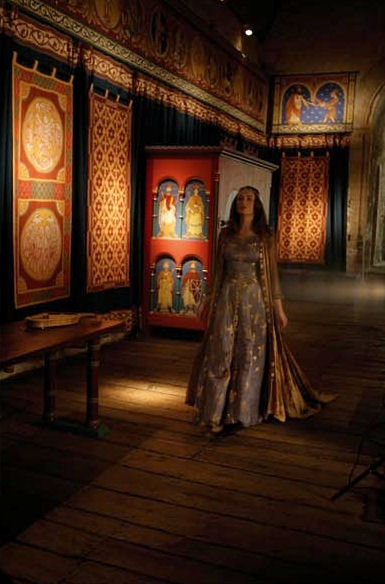

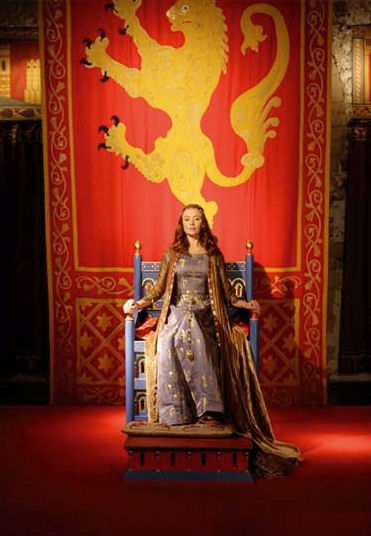



Above: six shots from the jacket shoot in the Great Tower at Dover Castle, which has been beautifully refurbished to show what the state rooms and service quarters would have looked at in the 1180s, in the time of Henry II and Eleanor of Aquitaine.
MISCELLANY
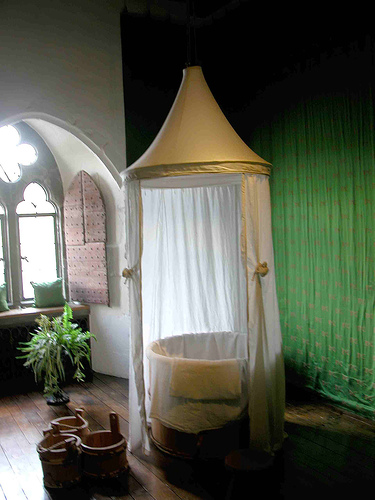
In medieval times, bath tubs were wooden and in the houses of the rich they were always lined with linen sheets, which were also hung over the tub like a canopy. The word `gear`, meaning equipment, is recorded c.1200, so was probably in use in Eleanor`s time.
In the book, the grey image in the labyrinth is whatever the reader thinks it might be - but I think it was the unquiet shade of Rosamund!
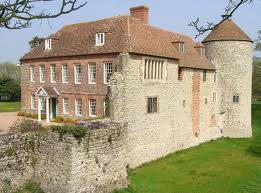
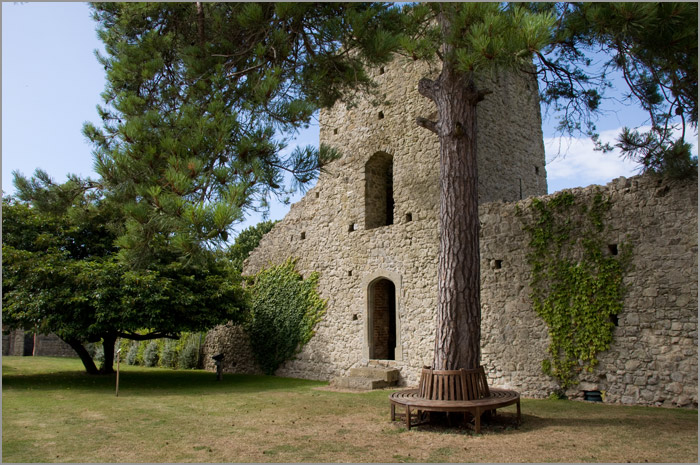
Distant relatives of Rosamund de Clifford owned Westenhanger Castle (above) in the 12th century, and it has been conjectured that Rosamund stayed there. However, this is only supposition, and in fact `Rosamund`s Tower` (above right) dates only from the 13th century. The castle is a largely undiscovered gem.
DID YOU KNOW...
...that ninety titles were considered for this book before I suggested The Captive Queen?
Those titles included: A Marriage of Lions (my favourite), The Eagle Rejoices, The Eagle and the Lion (original working title – deemed too military), The Devil`s Queen (hot favourite until we realised it had been used for a novel on Catherine de` Medici), Crown of Shadows, Eleanor, Great Eleanor, Crown of Sorrows, Royal Eleanor, A Royal Betrayal, An Incomparable Woman, Incomparable Queen, Noble Eleanor, Renowned Gracious Queen, Queen of Renown, Illustrious Queen, My Lady the Queen, The Plantagenet Queen, Incomparable Eleanor, The Diabolical Marriage, Eagle of the Broken Alliance, The Earth Was Not Enough, The Second Crown, Daughter of Aquitaine, Queen With Two Crowns, Eagle With Two Heads, Illustrious Queen, The Power and the Passion, Crown of Light, Queen of Prophecy, A Passionate Grief, Crown in Conflict, The Lion Rampant, Passionate Enemies, Passion`s Queen, Twice Crowned Queen, Queen From The South, Queen With Two Crowns, The Lion Queen, The Lion`s Queen, Huntress Queen, Siren Queen, Queen of Beauty, Passionate Betrayer, A Bitter Betrayal.
A FEW READERS have expressed the view that the sex scenes in this novel are too explicit. But my aim in The Captive Queen was to portray the passionate reality of the relationship between Henry and Eleanor, so that, when things go badly wrong between them, the reader understands exactly what it is that Eleanor has lost. I felt that a degree of explicitness was essential, and I myself find those scenes beautiful and moving. It never occurred to me that they would offend anyone, and in to my knowledge only five people have expressed concern about them. I was told that there had been adverse comments online, but I've only found a couple. One apparently asserted that my publishers had made me include those scenes for commercial reasons, but my editor initially deleted them because he felt they were a departure from my other novels (although in fact there is a graphic rape scene in Innocent Traitor). But I insisted on putting them back as I felt that they were right for the book, and I still do. I've discussed the matter with a lot of authors, and readers at events, and they have unanimously agreed. That said, I do not wish to offend anyone, so I will not be writing such explicit sex scenes in the future.
MY SON JOHN designed this jacket concept for the book.




